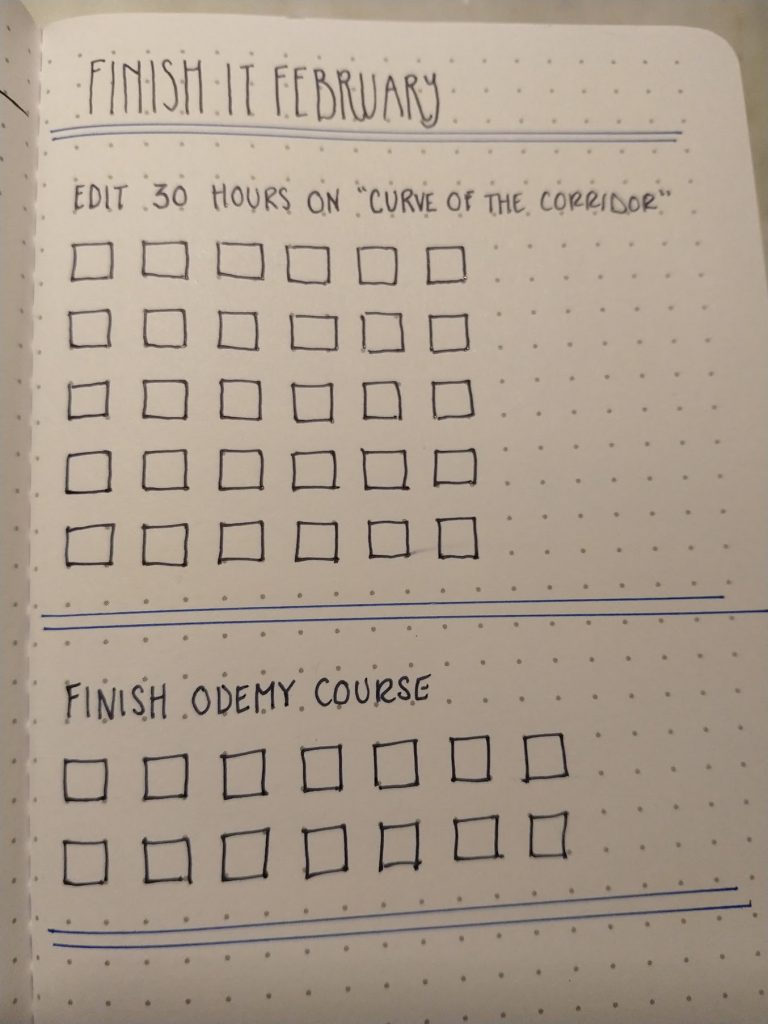Tell me if this sounds familiar to you:
- Get all excited about a creative project, like a novel or a website redesign or knitting a sweater
- Give yourself a reasonable end-date, like the end of the month
- Start out all bright-eyed and bushy-tailed, letting the enthusiasm carry you along until
- Hit a roadblock: an illness, emergency, or a mental block
- Spend a couple/few days out of your routine
- Now the ‘catching up’ becomes its own obstacle
- Get incredibly discouraged because there’s still so much left to do
- Realize there is no way you will be able to finish in time
- Stop working on it because ‘it won’t get done anyway’
- Have unfinished project hanging over your head until the heat-death of the universe.
The most familiar of these patterns is of course NaNoWriMo, where missing a few days in a row all but guarantees that catching up to where you OUGHT to be is an insurmountable mountain, unless you are a wizard or similar.
We’re used to formulating our goals towards an End. Usually a Thing, but sometimes an Outcome (be able to run 5K, for instance). It’s very human to focus on the reward, not the work it will take to get there–and combining that with a time-frame becomes “write a novel in 30 days” not “write 1,667 words until your novel is done”.
Timeframes are good; SMARTY relies on them. But they aren’t just a means to an end–they can also be the goal itself, and for projects or lives that are in flux, they can be the way to salvage your enthusiasm, helping you focus on the work you’ve already put into the project, not only how far yet you have to go.
If you’re the sort of person that starts extremely strong but then fizzles out, try turning your goals into spending a specific amount of time on the project instead. If you have additional struggles in your life–full-time work, or kids, or school, or disabilities–you can set that specific time down nice and low, low enough that it’s ridiculous not to spend the time on it. There’s no set amount, and even 15 minutes a day begins to add up. (This is also a helpful tool when the project in question does not have break-down sections.)
Let’s take knitting a sweater as an example. It’s a simple, fairly linear, fairly compact project that doesn’t rely on other people’s schedules.
So. You want to knit yourself a sweater. You’ve completed a couple of scarves, but now you want to take on something more challenging. Can you do it in a month? Maybe. But what if you get sick or work is extra busy? What if you are just too tired because it’s the middle of winter and dark and cold? Can you still get it done now? Can you do a whole sweater in a single month?
Are you getting discouraged already? I would be. Knitting that much sounds exhausting.
What if making a sweater in a month isn’t your goal, but knitting for fifteen hours is? Half-an-hour a day–but–and this is the best part–not every day. Because you know that on Saturday you’ll be curled up on the couch for a couple of hours watching your favourite UK murder village drama, and you’ll probably knit up a decent amount of inches. If knitting becomes part of your routine every evening, maybe you’ll get an hour done. Or maybe you won’t, maybe an hour is too hard to scratch out. But the good days and the bad days will even out.
You won’t have a whole sweater. But you’ll also now know exactly how much work it takes to see progress. And finishing the sweater wasn’t the goal–spending fifteen hours was. Maybe fifteen hours is easy-peasy to accomplish… maybe next month you’ll aim for twenty.
Which approach sounds more achieveable?
One thing I am working on, when people ask for my advice on productivity hacks or the like, is eliminating ‘just’ from my vocabulary and tasks. Just write every day. Just sit down and do half an hour. Just plan it out. There’s a reason why the person isn’t doing that task already; a better approach is to circle around and find out what is blocking them from ‘just’ doing the thing. Maybe they need group motivation. Maybe there’s a neuro component. Maybe they aren’t using the right tools. Once you know what the obstacle is you can work around it. There are work-arounds for everything.
And that includes myself. I have stalled on the final proofing of Space Crazies–the one where I print the MS out and go through it line by line to make sure I’m not missing words or using the wrong tense because I edited the verb but not the sentence around it–and I ‘just’ haven’t done it. I should ‘just’ sit down and work on it but. I. haven’t.
Why?
Because it’s borrring and–since no one has requested a full yet–low-priority. Literally folding laundry is more interesting to me. So I haven’t ‘just’ found the time.
And now it’s February and I still haven’t done it and I hate the fact that it’s hanging over my head.
So I’ll take my own advice: setting a time-based goal (30 hours) and giving myself clear progress markers (squares to colour in) and a reward for when I hit 30 (TBD). Will I finish the MS before 30 hours? Quite probably. Will I do an hour a day? Fuck no! I hate it. Will I do 1.5-2hrs in a sitting? Quite possibly. Can I do 30 hours if I really push myself? Yes. It’s less than one work week. Will it be hard? FUCK YES IT WILL BE. I hate editing.
But it’s one month. And if I’m not done in 30 hours I’ll be so close to the finish line that I should be able to keep going. That’s the added benefit of time goals; you see the progress add up, even if you don’t finish The Thing.
So that’s what I’ll be doing this Finish It February. I hope you’ll join me.
P.S. Check-boxes and/or stickers on a calendar work very very well to support this system. There’s nothing like seeing how much you’ve already done to help propel you a little further.



Lilithe Bowman
This sounds like an excellent way to cultivate motivation. I think I’ll use it too!
15 hours of work on my 3D platformer project in the rest of February.
☑️☑️☐☐☐
☐☐☐☐☐
☐☐☐☐☐
That should be pretty easy to pull off, even if I miss some of my nightly hour sessions.
vfeistner
Half an hour a day, give or take! You can do it! 😀